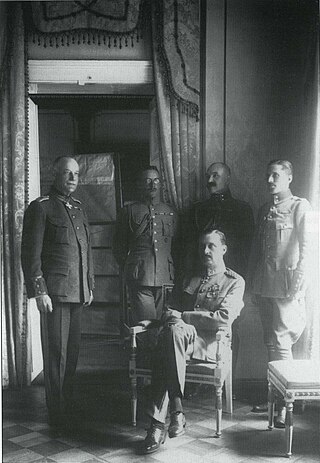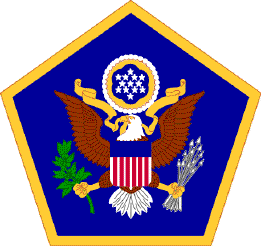
A battalion is a military unit, typically consisting of up to one thousand soldiers commanded by a lieutenant colonel and subdivided into a number of companies, each typically commanded by a major or a captain. The typical battalion is built from three operational companies, one weapons company and one headquarters company. In some countries, battalions are exclusively infantry, while in others battalions are unit-level organisations.
A company is a military unit, typically consisting of 100–250 soldiers and usually commanded by a major or a captain. Most companies are formed of three to seven platoons, although the exact number may vary by country, unit type, and structure.

Military ranks are a system of hierarchical relationships, within armed forces, police, intelligence agencies or other institutions organized along military lines. The military rank system defines dominance, authority, and responsibility in a military hierarchy. It incorporates the principles of exercising power and authority into the military chain of command—the succession of commanders superior to subordinates through which command is exercised. The military chain of command constructs an important component for organized collective action.

A platoon is a military unit typically composed of two to four squads, sections, or patrols. Platoon organization varies depending on the country and the branch, but a platoon can be composed of 20–50 troops, although specific platoons may range from 10 to 100 people. A platoon is typically the smallest military unit led by a commissioned officer. The platoon leader is usually a junior officer—a second or first lieutenant or an equivalent rank. The officer is usually assisted by a platoon sergeant.

A brigade is a major tactical military formation that typically comprises three to six battalions plus supporting elements. It is roughly equivalent to an enlarged or reinforced regiment. Two or more brigades may constitute a division.

A non-commissioned officer (NCO) is a military officer who does not hold a commission. Non-commissioned officers usually earn their position of authority by promotion through the enlisted ranks. In contrast, commissioned officers usually enter directly from a military academy, officer training corps (OTC) or reserve officer training corps (ROTC), or officer candidate school (OCS) or officer training school (OTS), after receiving a post-secondary degree.
Commander is a common naval officer rank as well as a job title in many armies. Commander is also used as a rank or title in other formal organizations, including several police forces. In several countries this naval rank is termed frigate captain.
Gunnery Sergeant (GySgt) is the seventh enlisted rank in the United States Marine Corps, above staff sergeant and below master sergeant and first sergeant, and is a senior non-commissioned officer (SNCO). It has a pay grade of E-7.
An executive officer is a person who is principally responsible for leading all or part of an organization, although the exact nature of the role varies depending on the organization. In many militaries and police forces, an executive officer, or "XO", is the second-in-command, reporting to the commanding officer. The XO is typically responsible for the management of day-to-day activities, freeing the commander to concentrate on strategy and planning the unit's next move.

Adjutant is a military appointment given to an officer who assists the commanding officer with unit administration, mostly the management of human resources in an army unit. The term adjudant is used in French-speaking armed forces as a non-commissioned officer rank similar to a staff sergeant or warrant officer but is not equivalent to the role or appointment of an adjutant.

The commanding officer (CO) or commander, or sometimes, if the incumbent is a general officer, commanding general (CG) or general officer commanding (GOC), is the officer in command of a military unit. The commanding officer has ultimate authority over the unit, and is usually given wide latitude to run the unit as they see fit, within the bounds of military law. In this respect, commanding officers have significant responsibilities, duties, and powers.

Quartermaster is a military term, the meaning of which depends on the country and service. In land armies, a quartermaster is generally a relatively senior soldier who supervises stores or barracks and distributes supplies and provisions. In many navies, a quartermaster is an officer with particular responsibility for steering and signals. The seaman is a non-commissioned officer rank; in some others, it is not a rank but a role related to navigation.
Commandant is a title often given to the officer in charge of a military training establishment or academy. This usage is common in English-speaking nations. In some countries it may be a military or police rank. It is also often used to refer to the commander of a military prison or prison camp.

The United States Marine Corps is organized within the Department of the Navy, which is led by the Secretary of the Navy (SECNAV). The most senior Marine commissioned officer is the Commandant of the Marine Corps, responsible for organizing, recruiting, training, and equipping the Marine Corps so that it is ready for operation under the command of the unified combatant commanders. The Marine Corps is organized into four principal subdivisions: Headquarters Marine Corps, the Operating Forces, the Supporting Establishment, and the Marine Forces Reserve.

Military organization (AE) or military organisation (BE) is the structuring of the armed forces of a state so as to offer such military capability as a national defense policy may require. Formal military organization tends to use hierarchical forms.

The California Cadet Corps (CACC), originally called the California High School Cadets, is a component of the California Youth and Community Programs Task, Task Force Torch. The California Cadet Corps is a paramilitary youth organization in California open to students in the college, high school, middle school and elementary school grades.

In United States Army units, a headquarters and headquarters company (HHC) is a company-sized military unit, found at the battalion level and higher. Considered one unit, a Headquarters and Headquarters Company is essentially two elements within one company. In identifying a specific headquarters unit, it is usually referred to by its abbreviation as an HHC. While a regular line company is formed of three or four platoons, an HHC is made up of the headquarters staff and headquarters support personnel of a battalion, brigade, division, or higher level unit. As these personnel do not fall inside one of the regular line companies of the battalion, brigade, or division, the HHC is the unit to which they are administratively assigned. The typical personnel strength of an average HHC is 80 to 110.

In the United States, commander is a military rank that is also sometimes used as a military billet title—the designation of someone who manages living quarters or a base—depending on the branch of service. It is also used as a rank or title in non-military organizations, particularly in law enforcement.
A headquarters and service company is a company-sized military unit, found at the battalion and regimental level in the U.S. Marine Corps. The U.S. Army equivalent unit is the headquarters and headquarters company.

Captain in the U.S. Army (USA), U.S. Marine Corps (USMC), U.S. Air Force (USAF), and U.S. Space Force (USSF) is a company-grade officer rank, with the pay grade of O-3. It ranks above first lieutenant and below major. It is equivalent to the rank of lieutenant in the Navy/Coast Guard officer rank system and is different from the higher Navy/Coast Guard rank of captain. The insignia for the rank consists of two silver bars, with slight stylized differences between the Army/Air Force version and the Marine Corps version.












